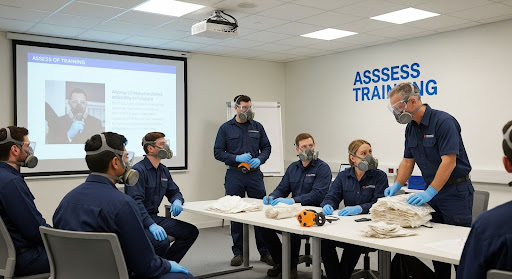When I first started working in corporate safety, one of the most nerve-wracking moments was learning about asbestos—its dangers, the regulations, and how much exposure is considered safe. The sheer weight of responsibility that comes with ensuring compliance and keeping employees safe made my head spin. But after years of focusing on risk assessments and OSHA regulations, I can confidently say that understanding permissible exposure for asbestos is not only crucial but achievable.
Asbestos has been linked to serious health conditions like lung cancer, mesothelioma, and asbestosis, and it’s no surprise that businesses must take specific actions to limit exposure. But how much exposure is too much? And what are the guidelines? Let’s break it down together and make sure you’re equipped to keep your workplace compliant and safe.
What Is Asbestos, and Why Is It Dangerous?
Before we jump into exposure limits, let’s talk about asbestos itself. It’s a naturally occurring mineral that was commonly used in construction, manufacturing, and even household items because of its heat resistance and insulating properties. However, it wasn’t long before the health hazards of asbestos became apparent.
When disturbed, asbestos fibers can be released into the air and inhaled, causing long-term respiratory damage. The particles lodge in the lungs, leading to inflammation and scarring that can cause serious conditions, even decades after exposure. It’s no surprise, then, that safety regulations are strict when it comes to managing asbestos in the workplace.
What Is the Permissible Exposure for Asbestos?

1. OSHA’s Limits for Asbestos Exposure
The Occupational Safety and Health Administration (OSHA) sets clear guidelines for permissible exposure to asbestos. According to OSHA standards, the permissible exposure limit (PEL) for asbestos is set at 0.1 fiber per cubic centimeter (f/cc) over an 8-hour workday. This means that over the course of a workday, an employee cannot be exposed to more than this concentration of asbestos fibers in the air.
These guidelines are crucial for businesses that deal with asbestos, whether it’s in manufacturing, construction, or even demolition work. The concentration of asbestos fibers in the air must be regularly monitored, especially in environments where asbestos is still present.
2. Short-Term Exposure Limits
While the 8-hour limit is the baseline, there are also short-term exposure limits to consider. OSHA’s short-term exposure limit for asbestos is 1.0 f/cc over a 30-minute period. This is designed to prevent spike exposures where the concentration of asbestos fibers could briefly exceed safe limits, even if the long-term exposure is controlled.
For businesses, this means implementing control measures that minimize asbestos release, especially in high-risk situations like demolition or renovations. More frequent monitoring and better ventilation are just a couple of strategies that can be used to keep these short-term spikes in check.
How Do You Measure Asbestos Exposure?

1. Air Sampling and Monitoring
To measure whether an area is compliant with OSHA’s standards, air sampling is required. This involves taking air samples throughout the workspace and analyzing them in a lab to determine the fiber concentration. The samples are typically taken using specialized equipment, such as pump devices that pull air through filters. These filters capture the asbestos fibers, which are then analyzed.
Regular air monitoring ensures that the permissible exposure limits are not exceeded and that employees are not exposed to dangerous levels of asbestos. The more frequent and detailed the monitoring, the safer the workplace.
2. Personal Monitoring Devices
Another tool businesses can use to track asbestos exposure is personal monitoring devices. Employees wear these portable devices while they work in areas that may be contaminated by asbestos. They provide real-time data, helping safety managers make immediate decisions if fiber levels approach the permissible limits. This proactive approach minimizes risk and ensures employees’ health is prioritized.
How Can You Minimize Asbestos Exposure in the Workplace?
1. Implementing Proper Safety Measures
It’s not just about monitoring exposure levels—control measures are essential to keep asbestos fibers from being released into the air in the first place. This can include:
- Wet methods: Wetting asbestos materials prevents fibers from becoming airborne during handling.
- Containment: Using sealed enclosures or plastic sheeting to isolate areas where asbestos is disturbed.
- Proper ventilation: Ensuring that workspaces have proper exhaust ventilation that filters out airborne fibers.
2. Training and Personal Protective Equipment (PPE)

Training your employees to recognize asbestos-containing materials and understand how to handle them safely is crucial. Proper training should include the correct use of PPE, such as respirators, gloves, and protective clothing. This ensures that workers are fully protected during tasks that may involve asbestos.
Also Read: Is Asbestos Still Used? A Modern Look at an Old Danger
Frequently Asked Questions
1. How do I know if my workplace has asbestos?
If your building was constructed before the 1980s, there’s a good chance it could contain asbestos, particularly in insulation, flooring, and roofing materials. A professional asbestos inspection is necessary to identify where it’s located and whether it poses a risk. Regular air monitoring will also help detect dangerous levels of asbestos fibers in the air.
2. What happens if exposure limits are exceeded?
If exposure limits are exceeded, it could result in serious health consequences for employees. The company could face fines, penalties, and even litigation if they fail to adhere to OSHA regulations. Employers are responsible for maintaining a safe work environment, and this includes controlling asbestos exposure.
3. Can I remove asbestos myself?
No, asbestos removal should only be performed by licensed professionals trained to handle the material safely. DIY removal is risky and can expose you and others to harmful fibers. Hiring certified asbestos abatement contractors ensures the material is removed according to OSHA guidelines and disposed of properly.
4. How often should I monitor asbestos levels?
The frequency of asbestos monitoring depends on the workplace environment. In areas where asbestos is known to be present or where disturbances are common (like construction sites), more frequent monitoring is recommended. If asbestos is being actively removed or disturbed, constant air sampling is required to ensure worker safety.
Safeguard Your Workforce, Safeguard Your Business
Ensuring that your workplace is in compliance with permissible exposure for asbestos standards is a vital part of maintaining both the health of your employees and the success of your business. By following OSHA’s regulations, investing in regular monitoring, and implementing safety measures, you can reduce the risks associated with asbestos exposure and keep your team safe.
Asbestos may still be present in many industries, but with the right precautions, you can manage it safely and effectively. Your commitment to safety not only protects your workers but also ensures that your business remains on the right side of the law.



